Wheat 2 School

March/April 2023 California Bountiful magazine
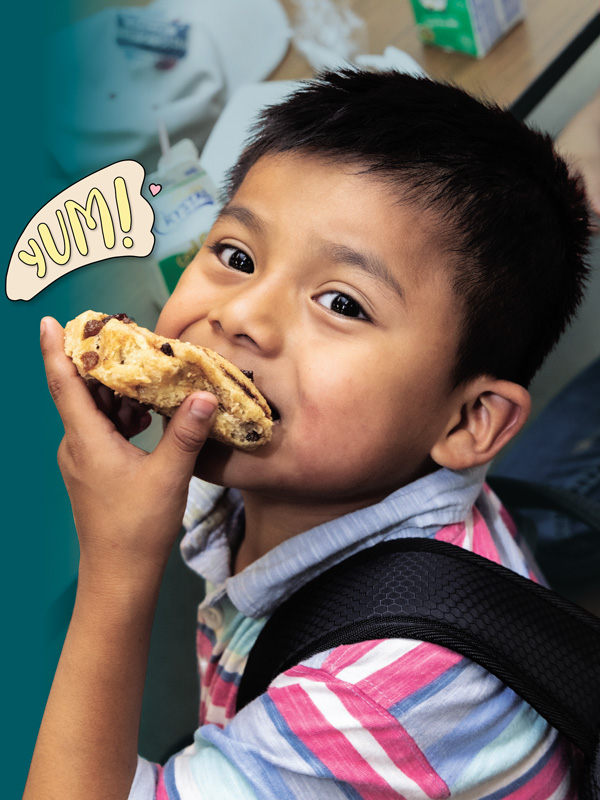
Project takes ‘farm to
school’ to a new level
Story by Ching Lee
Photos by Richard Green
Considering the agricultural mecca that is the Golden State, it may come as no surprise that many school cafeterias take advantage of the bounty by serving fresh, California-grown foods as part of the state farm-to-school program.
For years, schools have been bulking up their salad bars with fruits and vegetables from local farms and using more locally grown ingredients in student meals. Now, some school districts are taking “farm to school” to a new level by adding a major food staple to the menu: local wheat.
The endeavor has proved lofty because unlike fresh produce, which is ready to eat, wheat must be turned into flour before it can be used to make bread, pasta and other baked goods.
“With a carrot or lettuce or whatever, you can take that into the kitchen, wash it and serve it,” says Merced County farmer Jon Eck. With grains such as wheat, “the need for a processing step in between the field and the mill that makes the finished product makes it difficult.”

First in the nation
The challenge did not deter two school districts in San Luis Obispo County from taking the plunge. The idea for the so-called “wheat 2 school” project came from Claudia Carter, executive director of the California Wheat Commission, who says she wanted to convince school food authorities that buying their own wheat and milling it themselves is worthwhile. Best yet—they can make kid-approved whole-grain products without compromising nutritional value.
“It’s a way to prove to the world and to everybody out there: One, kids like it, they will eat it. And two, that we can increase the whole grain consumption of children through the school lunch programs,” Carter says.
Thanks to state and federal grants aimed at bolstering farm-to-school programs, Shandon Joint Unified School District and San Miguel Joint Union School District last year became the first public schools in the state to procure locally grown wheat from California farmers, with Eck being one of them. The funding allowed the districts to acquire their own stone mill—housed at Shandon, the first public school in the nation to have such equipment on site. The money also allowed the wheat commission to provide training to school staff so that they can make their own flour and recipes that use 100% whole grain.
Current federal school meal nutrition standards call for at least 80% of the weekly grains in school lunches and breakfast items to contain 50% or more whole grains. Citing research that finds less than 1% of U.S. children eat the recommended amount of whole grains in their diet, Carter says she wanted to help schools reach 100% whole grains in the wheat products they serve.

‘Amazing’ taste
Now that she operates her own mill, Gelene Coelho, food service director for the Shandon school district, says she can use the entire grain, not just the starchy middle part that goes into refined flour. By using 100% of the wheat kernel, her baked goods are more nutrient dense, and “the kids haven’t complained at all,” she adds.
“The taste is amazing,” Coelho says. “I wish we had taste-a-vision or something, so people can understand what this is, what it’s really about.”
The goal, she says, is to purchase about 6,000 to 8,000 pounds of grain a year. She mills 150 to 300 pounds a week, an amount shared between the two school districts. The wheat purchases allow the districts to make some baked goods from scratch, but items such as sandwich bread and hamburger buns come from a local bakery that makes 50% whole grain products, says Lauren Thomas, food and nutrition services director at San Miguel.
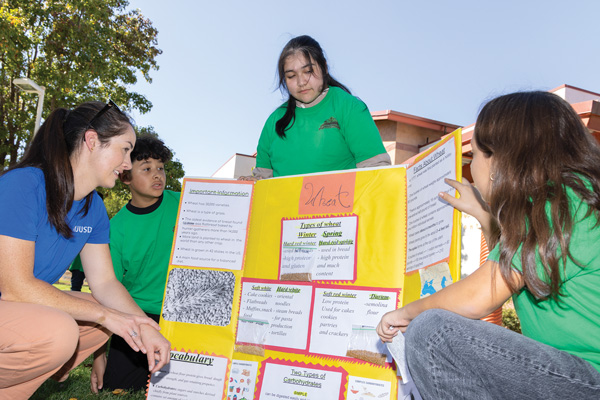
Building minds and bodies
The education component of the program, which the commission helped develop, incorporates lessons on math, science and history that relate to wheat and agriculture, Carter says.
At San Miguel, Christina Wilkinson, who teaches agriculture to sixth graders at Lillian Larsen Elementary School, runs the school garden that includes a small field of wheat that students helped plant. Her lessons range from the wheat plant itself to where it comes from, what it needs to grow and its nutritional value.
At the end of the school year, her students share what they learned in a presentation to other elementary students. An afterschool cooking class further connects the dots, with students harvesting the wheat from the school garden, grinding it into flour and making pasta noodles, muffins, cookies and pizza dough.
“For them to harvest it and actually see the berries or the kernels from this modified grass … that was an ‘aha’ for them,” Wilkinson says.
By exposing children to whole grains at an early age, Thomas says the hope is to shape their palates so that they form healthy eating habits that last. In this second year of the program, she says students are throwing less away and more willing to try new foods.
“You teach the kids, and the kids go home and teach the parents,” she says. “It’s slow to change, but I think it’ll change more and more every year. It’s just nice to see the kids going home and telling their parents, ‘I want to eat this or taste this.’”
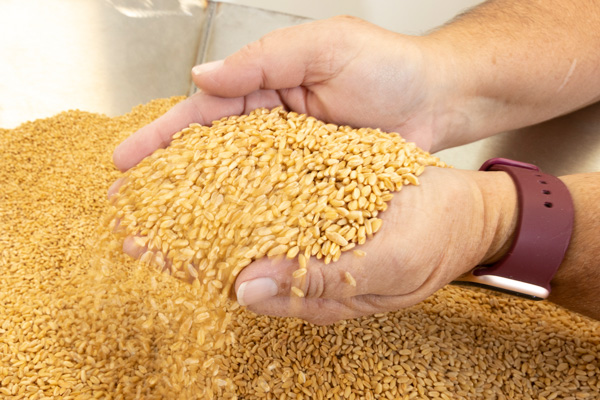
Benefits beyond the classroom
With a background as a registered dietitian and a trained chef, Thomas says school districts such as San Miguel and Shandon are beginning to change the narrative that “school food is crap.” They’re offering nutritious food that’s also delicious, she says. They’re also showcasing what local farms are producing, thereby supporting farmers and their businesses, she adds.
“I think people are slowly recognizing that we’re putting those dollars and those federal funds back into our local community,” Thomas says. “I think that part is so, so, so important.”
There’s also recognition that farm-to-school projects such as “wheat 2 school” would not be sustainable without government and public support. Eating locally and buying directly from farmers is more expensive, teacher Wilkinson points out.
“That could be a problem if school districts don’t have the funding,” she says.
‘Showcasing what’s possible’
As one of the most traded agricultural commodities in the world, wheat is handled in economies of scale, and the amount of unmilled wheat the two districts currently buy is considered small. They have to look to small-scale farmers such as Eck, who farms about 16 acres and sells mostly to people who run cottage bakeries that make 100 to 200 loaves a week.
“(The school districts) were looking at this huge grain infrastructure and wondering how they can tap into it, and it’s really difficult, so getting connected with small local farmers is a better path it seems,” he says.
But it does cost more, he acknowledges. With a harvest of about 16,000 pounds of wheat, most grain elevators would not even take his crop unless it’s at least 100,000 pounds, he says, or they would charge a “huge fee” to handle his small lot.
“I’m paying top dollar for everything because I have this small amount,” he says. The commodity system, he adds, “works, and it’s super-efficient, but it’s not flexible.”
Carter at the wheat commission acknowledges that the process “does sound complicated,” and that without continued grant funding, what Shandon and San Miguel are doing “is probably temporary.” But she says they are also proof of concept that could pave the way for more school districts to follow. She notes that South Monterey County Joint Union High School copied what the two school districts did and received a grant, which will allow it to purchase a stone mill.
“It’s like planting a seed,” she says. “It’s showcasing what’s possible.”
More schools are
cooking from scratch
Even as more school districts look to farmers to supply fresh produce—and now wheat—for their meal programs, they may find that some of their schools lack the infrastructure to do actual cooking.
Until more recent years, school districts had been moving away from operating full-service kitchens, as “it is much easier” to feed heat-and-serve meals, says Lauren Thomas, food and nutrition services director for San Miguel Joint Union School District.
“It was a trend for a long time to use central kitchens and then package everything and send it out to just be reheated,” says Gelene Coelho, food service director for Shandon Joint Unified School District.
But the practice meant less control over the quality of the foods districts served.
“So much of the stuff that was bought was prepackaged, processed, not locally grown,” Thomas says.
With renewed emphasis on healthier school meals and expansion of the farm-to-school movement, more districts are returning to cooking from scratch. In a 2020 survey conducted by the University of California, Berkeley, nearly one-third of California public school food-service directors who responded reported high levels of scratch cooking, with 16% saying they do little to no scratch cooking. They overwhelmingly cited lack of funding as the biggest obstacle to doing more scratch cooking. The study estimated $5.81 billion is needed to make all California public school kitchens scratch-cooking capable.
“You have to have more manpower behind it because it does take more time,” Coelho says. “But it’s also better for the kids.”

